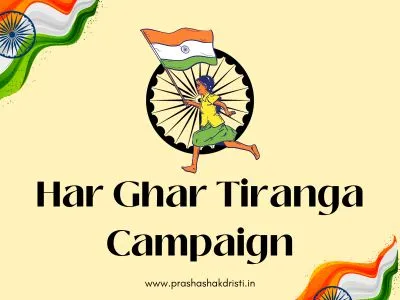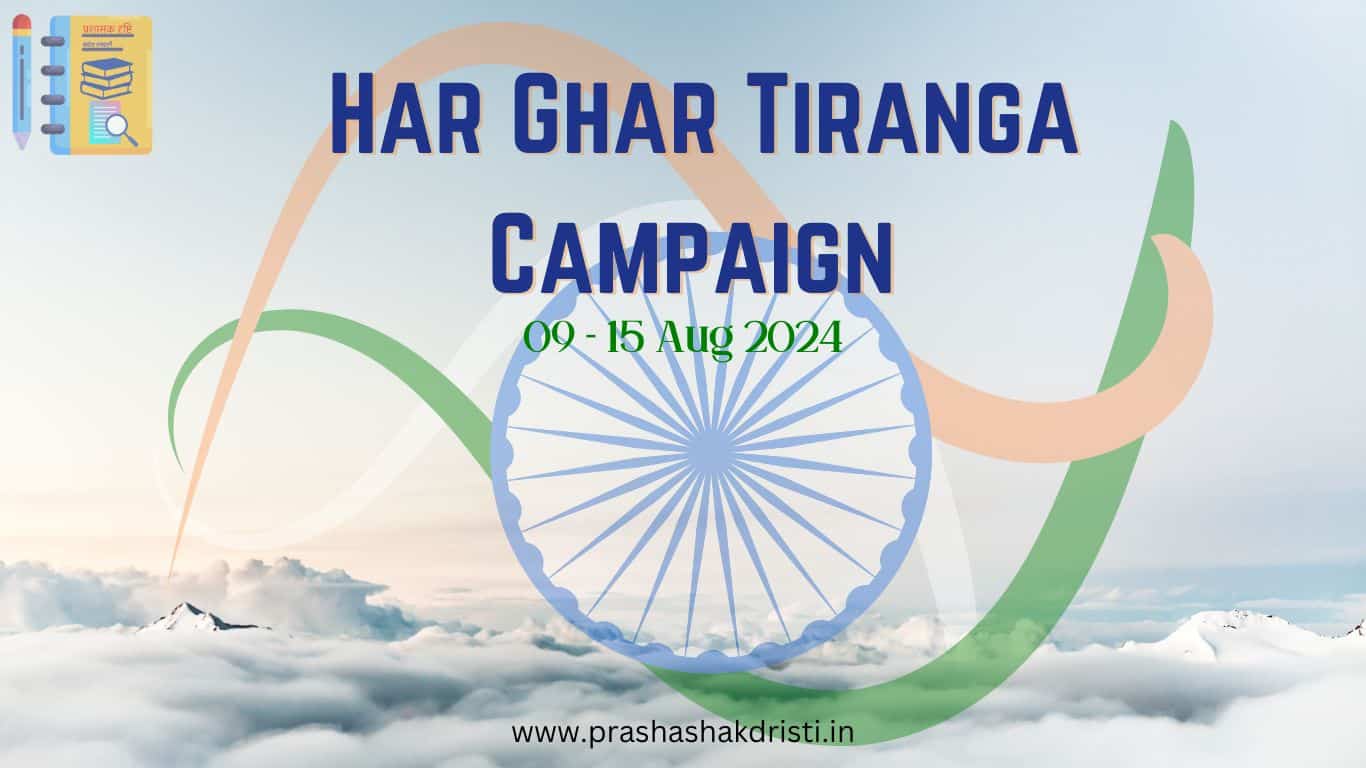Our relationship with the national flag has been more formal and institutional than personal. The Har Ghar Tiranga campaign is a significant initiative. The “Azadi Ka Amrit Mahotsav” is a campaign by the Government of India to celebrate 78 years of India’s independence and the glorious history of its people, cultures, and achievements. The “Har Ghar Tiranga” campaign, in the 78th year of independence, represents our collective commitment to the nation by bringing the national flag home.
Har Ghar Tiranga Campaign Kya hai?
The purpose of the “Har Ghar Tiranga” campaign is to instill a sense of patriotism in the hearts of the people and to promote awareness about the Indian national flag. This campaign will be conducted from 9-15August, 2024.
History of National Flag of India
The national flag of India, commonly known as the Tiranga, is a horizontal rectangular flag featuring three distinct colors: saffron, white, and green. At its center is the Ashoka Chakra, a navy blue 24-spoke wheel.
The Indian Constituent Assembly officially adopted the national flag on July 22, 1947, and it became the official flag of the Union of India on August 15, 1947. The flag was later retained by the Republic of India. In India, the term ‘tricolour’ is synonymous with the national flag.
The design of the Tiranga is primarily based on the Swaraj flag, which was associated with the Indian National Congress and significantly modified by Mahatma Gandhi. In 1947, Jawaharlal Nehru replaced the charkha with the Ashoka Chakra in the flag’s final design.
Originally, the national flag was made from Khadi, a special hand-spun cloth made famous by Mahatma Gandhi. However, 2021 amendment allowed for the flag to be produced from polyester or machine-made fabrics. This amendment enabled the production of the Tricolour using materials such as polyester,cotton, silk, wool or khadi, whether hand-spun, hand-woven, or machine-made.
The Bureau of Indian Standards has outlined all the specifications and manufacturing processes for the national flag. The Khadi Development and Village Industries Commission holds the manufacturing rights and allocates them to regional groups. Currently, there are only four licensed units in India authorized to produce the national flag.
Key Highlights of the 2024 Har Ghar Tiranga Campaign
The 2024 edition of the Har Ghar Tiranga campaign has introduced several new features and initiatives to enhance participation and engagement. Some of the key highlights include:
- Digital Participation: The government has launched a dedicated website and mobile app for the Har Ghar Tiranga campaign. Citizens can upload pictures of their homes with the national flag and share them on social media platforms using the hashtag #HarGharTiranga. This digital participation has allowed millions of people to join the campaign from across the country, making it a truly inclusive initiative.
- Special Discounts on Flags: To make it easier for citizens to participate, the government has partnered with various online and offline retailers to offer special discounts on the purchase of national flags. These flags are available in different sizes and materials, ensuring that everyone can find one that suits their needs.
- Community Events: Various community events, such as flag hoisting ceremonies, cultural programs, and patriotic marches, have been organized across the country. These events aim to bring people together and foster a sense of camaraderie and national pride.
- Educational Programs: Schools and colleges have been actively involved in the Har Ghar Tiranga campaign. Educational institutions have organized special programs, such as essay competitions, debates, and quizzes, to educate students about the significance of the national flag and the importance of patriotism.
- Corporate Participation: Many corporate houses and businesses have also joined the campaign by hoisting the national flag at their premises and encouraging their employees to do the same. This has further strengthened the reach and impact of the campaign.
The Impact of the Har Ghar Tiranga Campaign
The Har Ghar Tiranga campaign has had a profound impact on the nation. Since its inception, the campaign has witnessed overwhelming participation from citizens across the country. It has succeeded in rekindling the spirit of patriotism and unity among the people, reminding them of their shared identity as Indians.
The campaign has also played a crucial role in promoting the significance of the national flag. For many, the act of hoisting the flag has become a deeply personal and emotional experience, symbolizing their love and respect for the country. The campaign has turned the national flag into a unifying symbol, transcending regional, linguistic, and cultural differences.
Moreover, the Har Ghar Tiranga campaign has strengthened the bond between the government and the citizens. It has shown that patriotism is not just about grand gestures but also about small acts of love and respect for the country. The campaign has empowered citizens to take pride in their nation and to contribute to its progress in their own ways.
What should keep in mind to incorrect display of National Flag?

To participate in the “Har Ghar Tiranga campaign”, it is essential to know the correct position of the flag:
- The national flag should not be displayed upside down, meaning the saffron band should not be at the bottom, and a damaged or disarranged national flag should not be displayed.
- The national flag should not be lowered in salute to any person or object.
- A damaged or disarranged national flag should not be displayed.
- No other flag should be placed equal to or above the national flag.
- The national flag should not be used as decoration, in festoons, rosettes, or buntings.
- The national flag must not be allowed to touch water, the ground, or the floor.
- The national flag should not be hoisted simultaneously with any other flag on the same flagpole.
- The national flag should not be used to cover a speaker’s desk, nor should it be draped over a speaker’s platform.
- The national flag should not be used as a part of a costume or uniform below the waist, nor should it be embroidered or printed on items such as pillows, handkerchiefs, napkins, undergarments, or any dress material.
Who can display the National Flag on car?
According to Paragraph 3.44 of the Flag Code of India-2002, the privilege of flying the national flag on motor cars is limited to the following individuals:
- The President of India
- The Vice President of India
- Governors and Lieutenant Governors
- Heads of Indian missions/posts
- The Prime Minister of India
- Cabinet Ministers, Ministers of State, and Deputy Ministers of the Union
- The Chief Ministers and Cabinet Ministers of states and Union Territories
- The Speaker of the Lok Sabha, Deputy Speaker of the Lok Sabha, Deputy Chairman of the Rajya Sabha, Speakers of State Legislative Assemblies, and the Deputy Speakers of the State Legislative Assemblies and Union Territories
- The Chief Justice of India
- Judges of the Supreme Court
- Chief Justices of High Courts
- Judges of High Courts
Amendment in Flag code 2002
The rules regarding hoisting the tricolor in India fall under the Flag Code-2002, which came into effect on January 26, 2002. Previously, the rules for hoisting the tricolor were under the Emblems and Names Act of 1950 and the Prevention of Insults to National Honour Act of 1971. The Flag Code is divided into three parts:
- Specifications about the size of the tricolor and how it should be made.
- Rules related to hoisting the tricolor by general public, educational institutions, and other organizations.
- Rules regarding the hoisting of the tricolor by the central and state governments and their affiliated organizations.
How to Participate and get Har Ghar Tiranga Certificate
Participating in the Har Ghar Tiranga campaign is simple and straightforward. Here are the steps you can follow to join this patriotic movement:
- Get a National Flag: Purchase a national flag from an authorized retailer or online store. Ensure that the flag adheres to the specifications outlined in the Flag Code of India, 2002.
- Hoist the Flag: On the designated days of the campaign, hoist the national flag at your home, office, or any other place of significance. Ensure that the flag is displayed with respect and dignity.
- Upload and Share: Take a picture of the flag at your home and upload it on the official Har Ghar Tiranga website or app. Share the picture on social media platforms using the hashtag #HarGharTiranga.
- Participate in Events: Join local community events, flag hoisting ceremonies, and cultural programs organized as part of the campaign. Encourage your friends and family to participate as well.
- Educate Others: Spread awareness about the Har Ghar Tiranga campaign and encourage others to participate. Educate them about the significance of the national flag and the importance of patriotism.
To get har ghar tiranga certificate you need to click link click here .
Conclusion
The Har Ghar Tiranga campaign is a shining example of how a simple initiative can have a profound impact on a nation. In 2024, as the campaign continues to inspire millions, it serves as a reminder of the power of unity and patriotism. By hoisting the national flag at their homes, citizens across the country are not just celebrating their love for the country but also reaffirming their commitment to its values and principles.
As we move forward, the Har Ghar Tiranga campaign will continue to play a vital role in fostering a sense of national pride and unity. It is a celebration of India’s rich history, cultural diversity, and democratic values. So, let us all join hands in this patriotic movement and proudly hoist the tricolor at our homes, for a brighter and more united India.
You can read other important article here लिंक !

